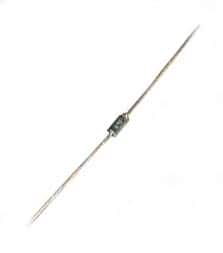Diodes are very commonly used semiconductor devices. They are mostly used as rectifiers for converting Alternating to Direct current. Their special characteristic of allowing current flow in only one direction makes them indispensable as rectifiers. Apart from rectification, various types of diodes are available for different purposes such as for generating light, microwaves, infrared rays and for various types of switching at high speeds.
For example, the power supply industry has been moving towards high speed switching because higher speed reduces the volume of magnetics used, which ultimately reduces the bulk and price of the units. For switching at high frequencies, diodes are also required to react at high speeds. Schottky diodes are ideal for this purpose, as their switching speeds approach nearly zero time. Additionally, they have very low forward voltage drop, which increases their operating efficiency.
As their switching speed is very high, Schottky diodes recover very fast when the current reverses, resulting in only a very small reverse current overshoot. Although the maximum average rectified currents for Schottky diodes are popularly in the range of 1, 2, 3 and 10 Amperes, Schottky diodes that can handle up to 400A are also available. The corresponding maximum reverse voltage for Schottky diodes can range from 8 to 1200V, with most popular values being 30, 40, 60 and 100 Volts.
Another very versatile type of diode used in the power supply industry is the Zener diode. All diodes conduct current only when they are forward biased. When they are reverse biased, there is only a very small leakage current flowing. As the reverse voltage increases to beyond the rated peak inverse voltage of the diode, the diode can breakdown irreversibly and with permanent damage.
A special type of diode, called the Zener diode, blocks the current through it up to a certain voltage when reverse biased. Beyond this reverse breakdown voltage, it allows the current to flow even when biased in the reverse. That makes this type of diode very useful for generating reference voltages, clamping signals to specific voltage levels or ranges and more generally acting as a voltage regulator.
Zener diodes are manufactured to have their reverse breakdown voltage occur at specific, well-defined voltage levels. They are also able to operate continuously in the breakdown mode, without damage. Commonly, Zener diodes are available with breakdown voltage between 1.8 to 200 Volts.
Another special type of diode called the Avalanche diode is used for circuit protection. When the reverse bias voltage starts to increase, the diode intentionally starts an avalanche effect at a predetermined voltage. This causes the diode to start conducting current without damaging itself, and diverts the excessive power away from the circuit to its ground.
Designers use the Avalanche diode more as a protection to circuits against unwanted or unexpected voltages that might otherwise have caused extensive damage. Usually, the cathode of the diode connects to the circuit while its anode is connected to the ground. Therefore, the Avalanche diode bypasses any threatening voltage directly to the ground, thus saving the circuit. In this configuration, Avalanche diodes act as clamping diodes fixing the maximum voltage that the circuit will experience.

